Investigation: Spring Energy Products Contain Less Than Half of Claimed Calories

By Brady Burgess and Johanna Ohm for iRunFar, which first published this story.
Spring Energy’s Awesome Sauce gel was a product that seemed too good to be true.
A staple in many ultrarunners’ nutrition plans, it promised to deliver high carbohydrates and calories in a small package of easy-to-digest applesauce-like gel. The 180-calorie gel offered nearly double that of its competition, with 45 g of carbohydrates and a mouthfeel and consistency tolerable for late in a race, when most foods sound unbearable.
In April, a Reddit user posted results of a simple dehydration test to estimate calories in Spring Energy’s Awesome Sauce, and suggested that the calorie and carbohydrate content was a fraction of what the label listed. The data from this simple, initial test inspired others to send multiple samples out for third-party lab nutritional analyses over the past month, including new results we’ve collected.
These results each confirm that Spring Energy’s Awesome Sauce contains less than 50% of the calories stated on the label. We also present evidence that gels made by seven other nutrition companies contain calorie totals that are close to the stated amounts and well within regulatory guidelines for accuracy.
Here, we look at the scrutiny that Spring Energy has experienced in the last month, examine the results of our lab testing of numerous gels, compare community members’ various testing methods and results thus far, and consider the trail ahead for both Spring Energy and consumers.
Why Carbs Are King in Endurance Running

Fueling is part of ultrarunning. To cover distances over multiple hours or days, ultrarunners need to eat and typically target ingesting between 150 and 450 calories per hour. As iconic ultrarunner Ann Trason once reminded us, “Ultramarathons are just a big eating and drinking competition with a little bit of running thrown in.”
Calories, specifically from carbohydrates, are key to performance. Ultrarunning and other endurance sports have followed a trend toward higher and higher carbohydrate fueling strategies, with research finding that higher carbohydrate fueling plans outperform lower carbohydrate fueling.
In 2021, Spring Energy released Awesome Sauce, a natural-food-based gel they claimed had 180 calories and 45 g of carbohydrate per 54g serving. Marketing of the product emphasized using whole foods that would lead to less gastrointestinal (GI) distress. These whole-food high-calorie gels came at a premium price of $4.80 per gel for a Spring Energy Awesome Sauce purchased May 2024 versus $1.60 for a Gu Energy gel.
Ultrarunners, shelling out hefty amounts of cash for a gel, thought Awesome Sauce provided more calories, more carbohydrates, and less risk of GI issues. The math was this: Awesome Sauce tasted great, had 80% more calories than a standard gel, and was made of high-quality natural foods that were worth paying more for. Awesome Sauce was a game changer — but only if the nutritional content on the label of 180 calories and 45 g of carbohydrates were true.

Spring Energy Comes Under Scrutiny
Reddit user u/sriirachamayo was skeptical. In April, the Reddit user posted a photo of a dehydrated Spring Energy Awesome Sauce, showing that the dry weight was a third of the carbohydrate weight listed on the label.
“If all of those grams are carbs,” u/sriirachamayo posted, “that corresponds to about 60 calories, not 180.” Other Redditors weighed in. Social media took to more dehydration experiments. Other people started looking into professional lab testing options.
On May 3, we started a GoFundMe to crowdfund third-party testing of Spring Energy Awesome Sauce, Spring Energy Canaberry, and energy gels from seven other brands. Meanwhile, others sent gels out for third-party testing, with the first results posted on Instagram by Sporthunger.de, a German/Austrian sports nutrition retailer.
On May 28, Jason Koop, an ultrarunning coach, author, and podcaster, posted results showing that samples he sent of Spring Energy Awesome Sauce for third-party testing had only 18 g of carbohydrate, compared to the 45 g claimed on the label, and a total of 75 calories compared to the 180 labeled. He also reported that other Spring Energy products’ calorie and carbohydrate content were below target and made the raw data reports available on his website.
The U.S. Food and Drug Administration (FDA) regulates that food labels contain at least 80% of the listed values on their labels for Class II nutrients, which includes total carbohydrates and no more than 120% of the labeled calories.
Variance in any product is expected from small deviations in manufacturing or differences in underlying ingredients. The FDA allows for variance in some nutrient values to account for this. Initial data coming in from several sources suggested Spring Energy was well outside these bounds.
Previous research on sports nutrition products has shown that discrepancies between labels and measured nutritional content can be widespread for other sports nutrition products. Given the preliminary data on Spring Energy’s Awesome Sauce and other Spring Energy products, we wanted to know if there were widespread discrepancies in other energy gels. Are all gel nutrition labels off? Is Spring Energy an outlier or the norm?
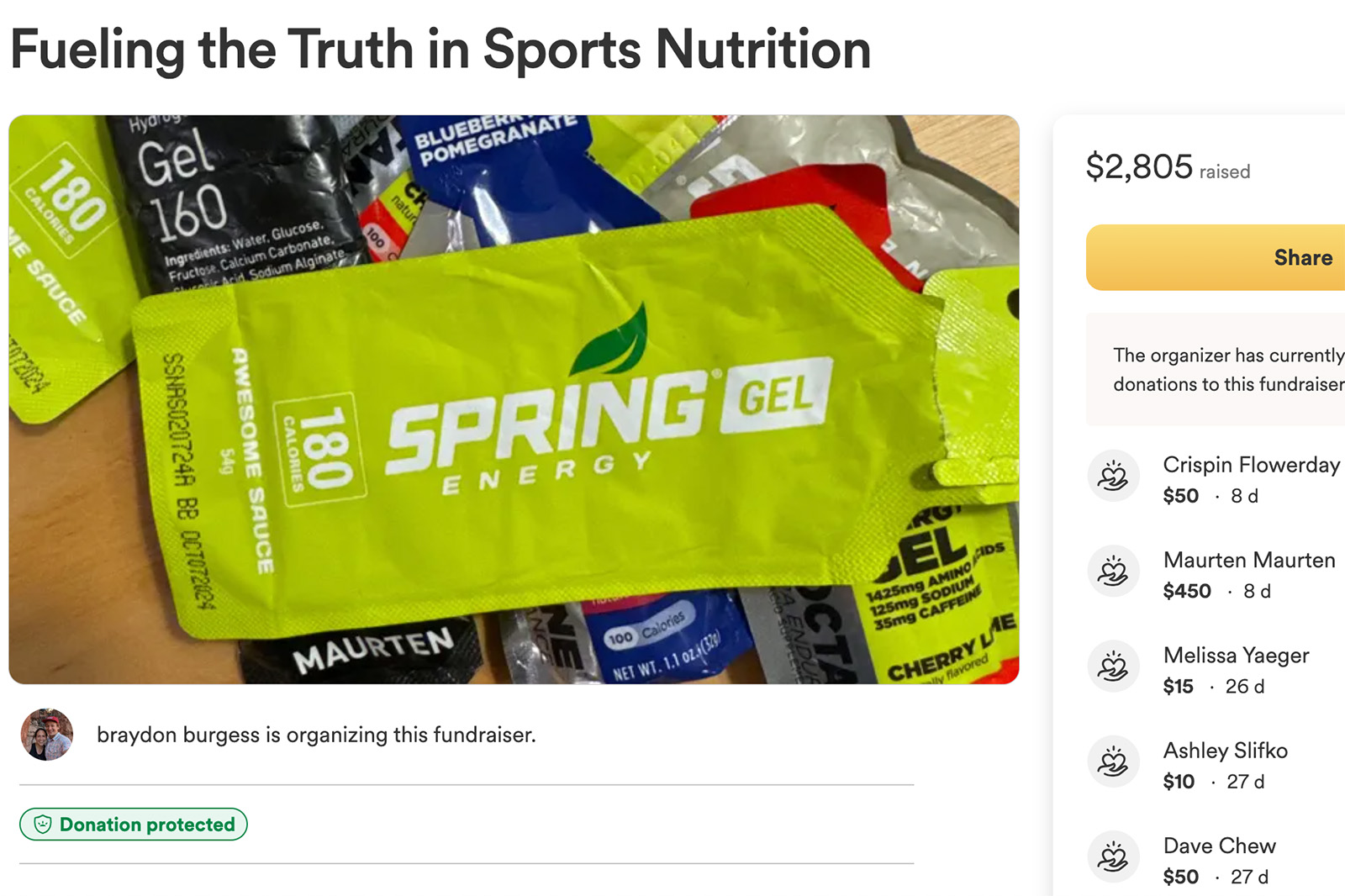
Ultrarunning Community Funds Third-Party Testing
With the help of 110 donors on GoFundMe, we raised $2,805 to send additional samples from Spring Energy and other gel brands out for third-party testing. We tested a total of 13 samples from nine energy gel products to evaluate which brands and products had discrepancies between their nutrition label and lab-tested nutritional data.
The tested products were:
- Spring Energy Awesome Sauce
- Spring Energy Canaberry
- Honey Stinger Acai Pomegranate Energy Gel
- Hüma Apples & Cinnamon Energy Gel
- Näak Apple and Maple Syrup Energy Puree
- Gu Energy Gel Strawberry Banana
- Maurten Gel 100
- Precision Fuel PF 90 Gel
- Science in Sport Beta Fuel Strawberry and Lime
We focused most of our testing effort on Spring Energy products to gauge how consistent the discrepancy in nutritional content between label and lab-measured values was for their products. We tested four Awesome Sauce samples and one Canaberry sample.
Spring Energy Awesome Sauce was tested from three different lots: one purchased directly from the brand’s website in May 2024, tested in duplicate, a second lot from online retailer The Feed purchased in March 2024, and a third lot from an older batch produced in 2023. Our sampling strategy aimed to collect data from across time points, batches, and suppliers.
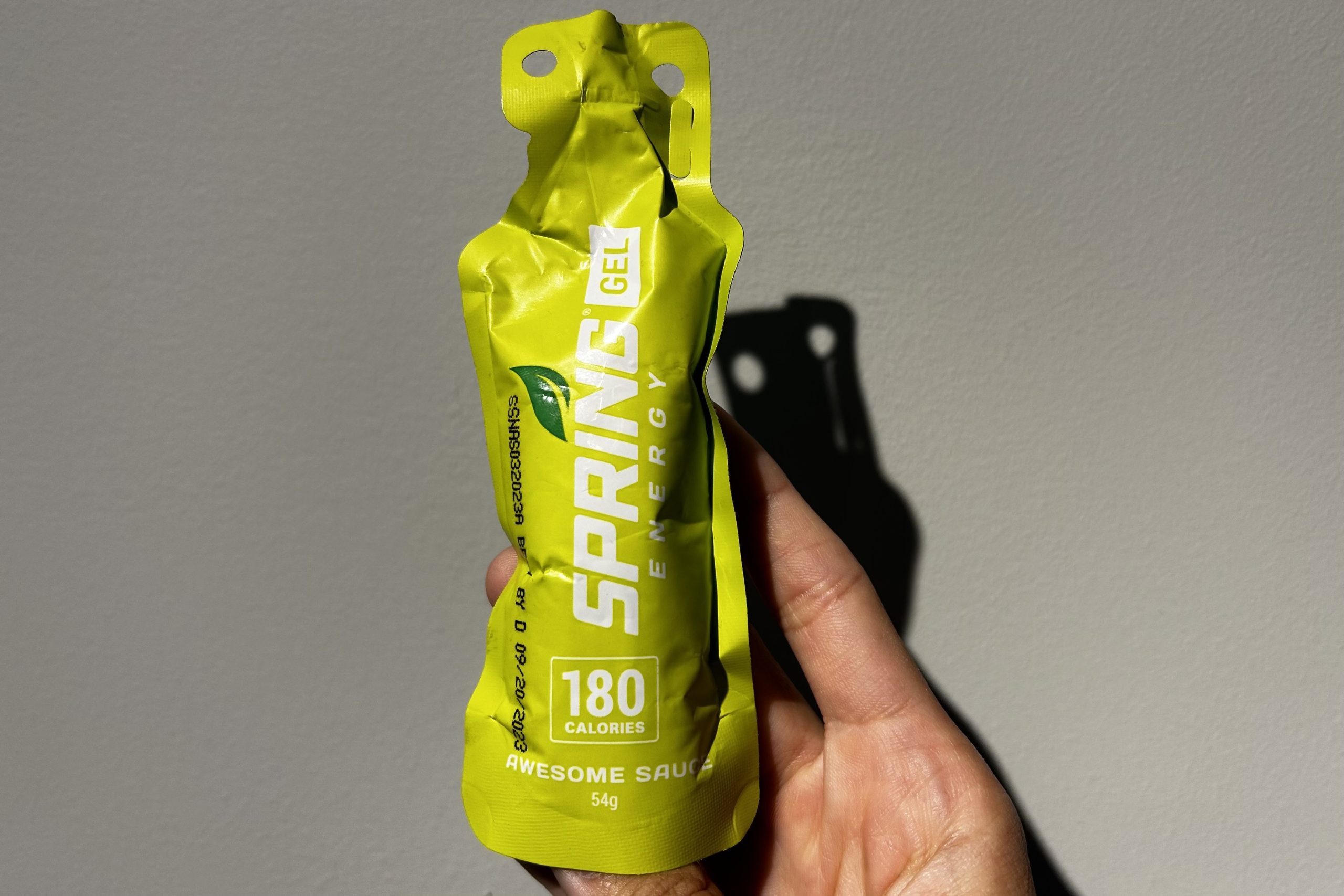
The seven other gel products tested were chosen for their history in the sport, popularity, or Reddit skepticism to verify their labels. We chose products that covered different brands, ingredient types, and, when possible, selected flavors similar to Awesome Sauce.
There are two basic ingredient types of energy gels: natural and refined. Natural gels contain ingredients derived from whole foods like fruits, grains, or minimally processed carbohydrate sources such as maple syrup or honey.
In the natural products category, we tested Spring Energy, Honey Stinger, Hüma, and Näak gels. Refined gels contain processed ingredients like maltodextrin and fructose. In the refined products category, we tested Gu Energy, Maurten, Precision Fuel, and Science in Sport gels.
Samples were sent to an accredited third-party lab for proximate analysis tests to measure total calorie, carbohydrate, fat, and protein content. The lab also measured the recoverable weight from each gel packet to compare the weight provided in a gel packet to the listed serving size.
Third-Party Testing of Spring Energy Nutrition
Data from our third-party test results and from other sources shared on social media are listed in the table below and compared to the product’s nutrition label (Table 1). All products except Spring Energy gels were found to comply with FDA label regulations of containing at least 80% of carbohydrates listed on their labels, and no more than 120% of listed total calories.
Per the listed serving size, Spring Energy Awesome Sauce had 13.5-17.2 g of carbohydrate, or 30-38% of the expected carbohydrates on the label, well below the FDA regulation of 80%. When accounting for recovered weight from the lab, Spring Energy Awesome Sauce gels ranged from 53 to 86 calories per packet and between 12 and 18 g of carbohydrates, only 29% to 48% of expected calories and 28% to 36% of expected carbohydrates based on the recovered weight of product per packet (Table 1).
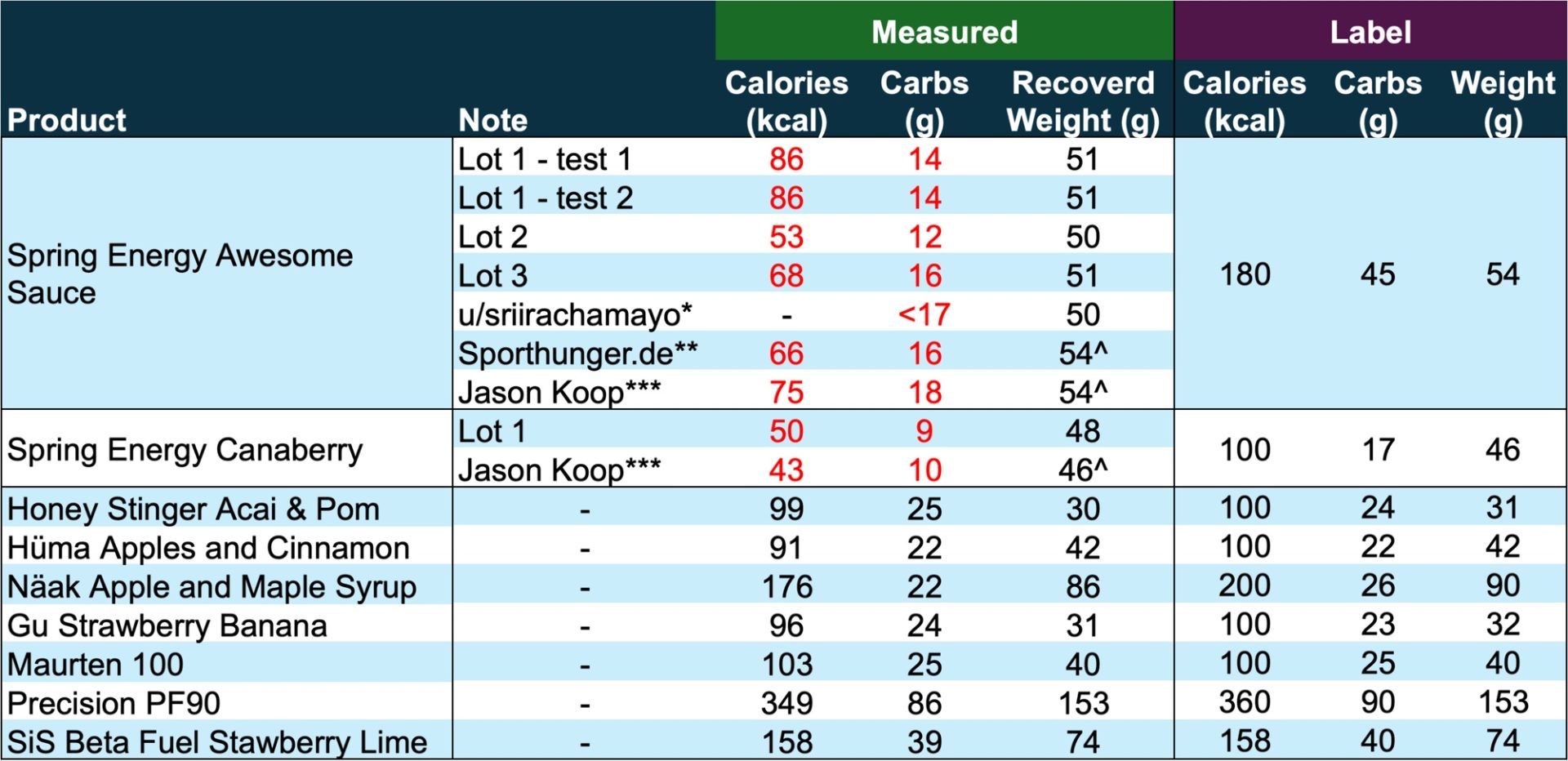
For the ultra curious, we have a supplementary table with calorie and carbohydrate contents as well as fat and protein contents based on a full serving size being consumed.
The lab measured the recoverable weight of product in each package to verify that the weight in each packet matched the recommended serving size (Figure 1). In addition to having lower total calories and carbohydrates per serving size, Spring Energy Awesome Sauce packets were underfilled with less recoverable weight than listed on the serving size.
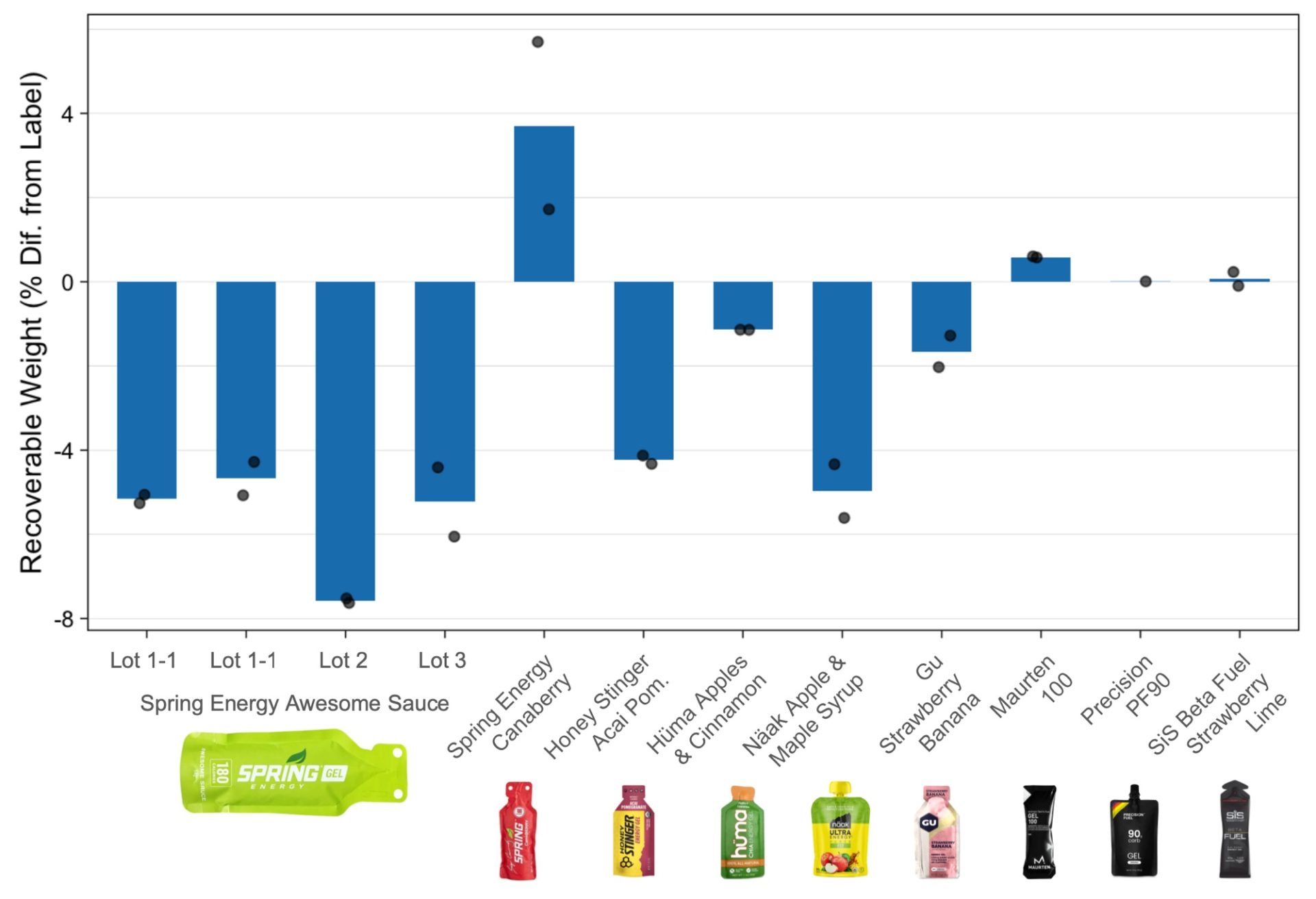
The average recoverable weight from Spring Energy Awesome Sauce packets was 51 g compared to the 54g serving size. The lab provided adjusted total calories and carbohydrates for the product weights they recovered, and we used these numbers to determine the actual deficit in carbohydrates and calories when using these products (Table 1; Figure 2).
Spring Energy Canaberry had more recoverable weight than listed on the package (48 g recovered compared to 46 g on the label; Figure 1) but was still under total calorie and carbohydrate claims from the label (Figure 2). All products’ total calories (blue) and total carbohydrates (orange) compared to their label are shown in Figure 2 below based on the recoverable weight of material per package.s
Again, all lots of Awesome Sauce tested had less than 50% of the listed calories and around 30% of the listed carbohydrates. Spring Energy’s Canaberry, similarly, had fewer carbohydrates and calories than labeled, despite having higher recoverable weight. All other products had 85% or more of their labeled calories and carbohydrates.
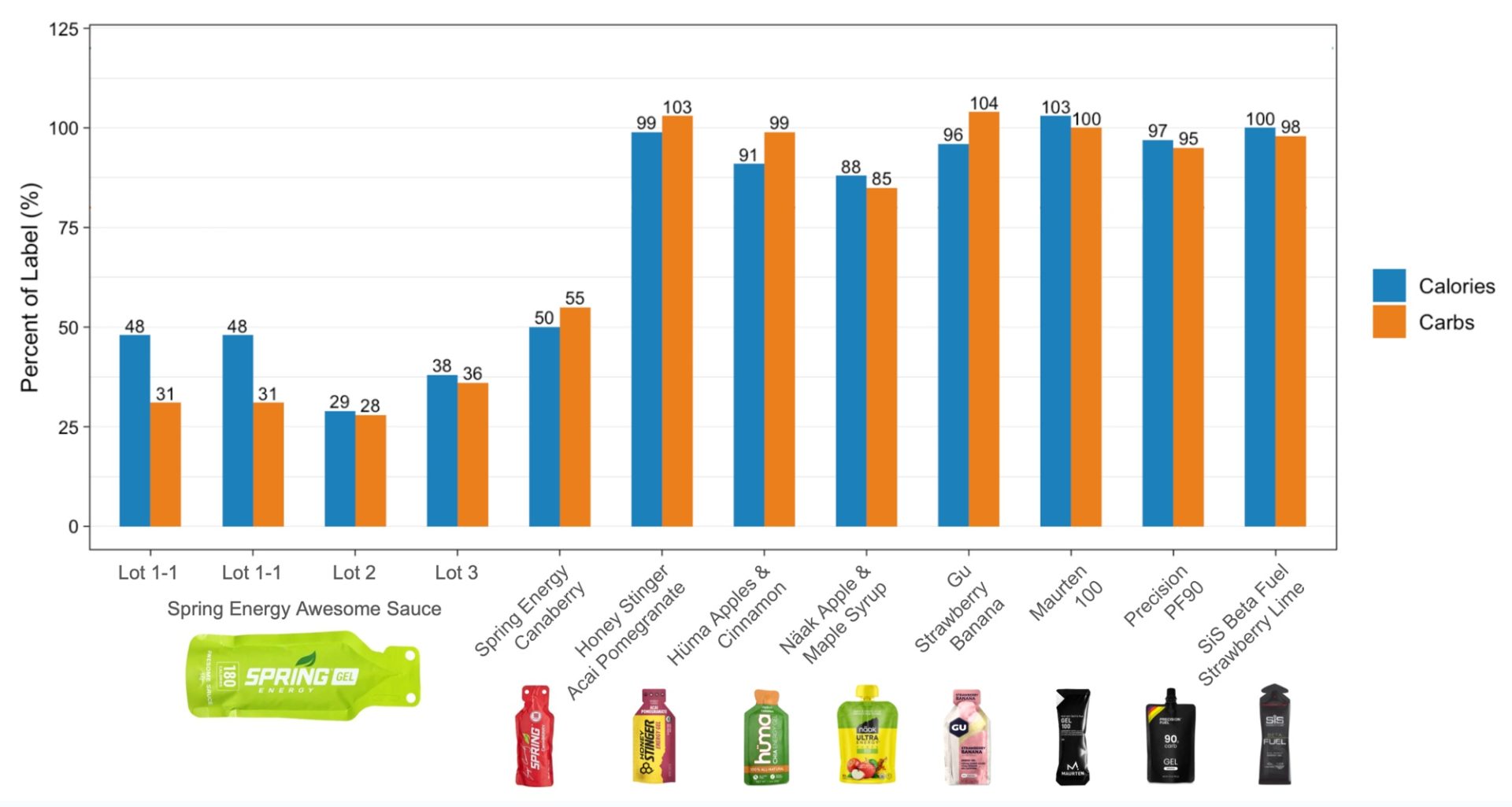
Honey Stinger, Hüma, and Näak are made from natural or a combination of natural and semi-refined products. We hypothesized that these products could be more variable in calories and carbohydrates, as they have ingredients that could be seasonably variable or inherently are less controllable than refined ingredients.
However, Honey Stinger and Hüma were just as close to their label as refined products, and Näak was slightly below but still within FDA label regulations. Näak’s packaging has a rigid mouthpiece and cap, which makes it more difficult to recover all the product from the container and may partially account for its lower calorie and carbohydrate values. Näak still had 88% of the expected calories and 85% of the expected carbohydrates, well within the FDA bounds.
Recoverable weight from Spring Energy’s Awesome Sauce was consistently the lowest of the products tested, despite having packaging similar to other gel products with high recovery amounts. Even with total calories and carbohydrates adjusted for the stated serving size rather than recoverable weight, Spring Energy products still came up between 44% and 72% short of the labeled amounts.
For refined-ingredient gels, we tested products from Gu Energy, Maurten, Precision Fuel, and Science in Sport. All the refined-ingredient products had calorie and carbohydrate amounts within 5% of the labeled amounts.
When fueling in an ultra, we want maximum calories, and we want to trust our fueling math based on what’s listed on the labels. For Gu Energy, Honey Stinger, Hüma, Maurten, Precision Fuel, and Science in Sport, the labels are spot on. Even with some product being lost to the package, the recoverable weights’ amount of carbohydrates and calories were 95% or greater than the calories and carbohydrates listed on the label.
For Näak, the recoverable weight was lower, likely because of the packaging, and calorie and carbohydrate content per serving size were also slightly lower than the label. With Näak gel, it may be useful to adjust calories by about 15% to make up for some of what’s listed on the label not making it into your system.
Based on this analysis, Spring Energy is the outlier, not the rule.
You can download all 12 data sheets from this analysis and see the full supplementary table that includes fat and protein.
Spring Energy’s Response
Last week, Spring Energy CEO and founder Rafal Nazarewicz posted a social media video acknowledging that at least some batches of gels had “lower than desired nutritional value,” and apologizing for the error.
We reached out to Nazarewicz for comment, and he responded that the brand has investigated its products in response to the data the public has generated. Nazarewicz said Spring Energy has “identified a couple of factors — a cooking method, processing of some ingredients and variation in supplier ingredients — that were leading to some batches becoming overly diluted, and unfortunately, failing to translate as desired with the calculations used with our formulation.”
Nazarewicz also indicated that Spring Energy will release more details about the nutritional content discrepancies and the company’s planned path forward in the coming weeks. Nazarewicz wrote in an email:
“Please know that our small team has been working tirelessly over these past several weeks to assess and rectify all possible sources of inconsistency and ensure we continue to offer reliable high-quality products that customers know and trust. We are confident that we have successfully remedied the issue and look forward to sharing further details with customers as we complete our full assessment over the next week or two.”
We’ll update this article if we receive additional relevant information from Spring Energy.
Stick With Spring Energy? Or Try Other Gels?
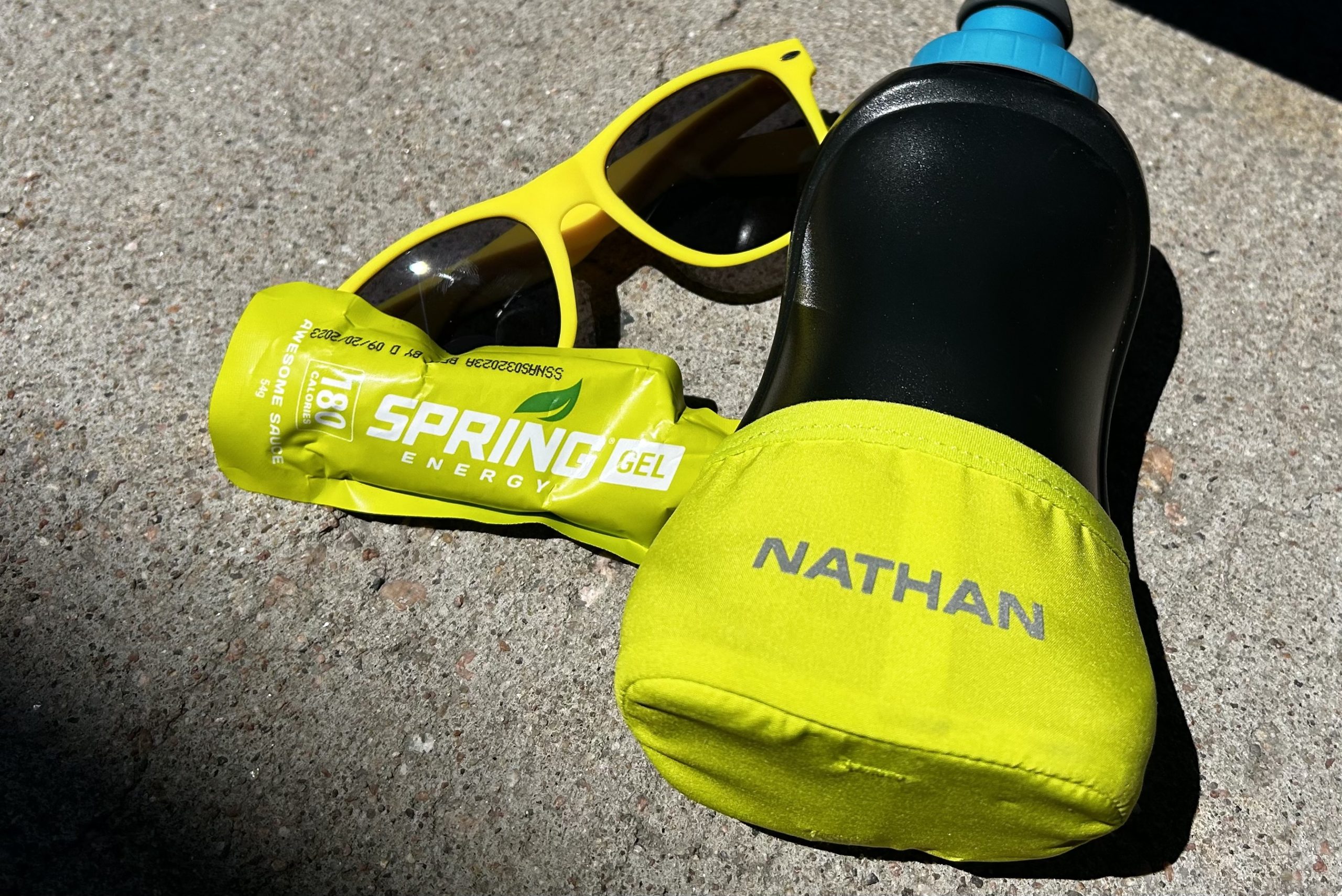
Spring Energy’s assertion that its low carbohydrate and calorie count is an issue of lot-to-lot variability is inconsistent with our data and that of others. Data from at least five separate lots with release dates between May 2023 and April 2024 show Awesome Sauce to consistently have calorie and carbohydrate contents 45% to 72% below what is claimed on the label (Table 1). Awesome Sauce is no longer available for sale on the Spring Energy website, but other products, like Canaberry, are.
Coherent information and specifics from Spring Energy on its manufacturing issues, how the company generated its nutrition labels, and how these methods went awry could help runners regain trust in these products. We’d also suggest the brand regularly test and share results of nutritional content estimates from a third-party lab.
Generating nutrition labels can be complicated and is often done using proprietary databases and software from third-party companies that some describe as error-prone and inaccurate. The FDA recommends, though it doesn’t require, that nutrition labels be validated by lab testing finished products rather than relying on software to generate labels.

According to its website, “FDA’s policy recommends that the nutrient values for labeling be based on product composition, as determined by laboratory analysis of each nutrient [rather than software estimates alone]. FDA continues to recommend the use of the Official Methods of the Association of Official Analytical Chemists International (AOAC).”
Proximate analysis tests using these FDA-recommended methods, like the ones run in our study, cost between $150 and $200 per sample. The tests are a reasonable cost for a company that is looking to instill confidence in consumers that their labels match the contents of the products we are relying on for performance.
Based on the data from other gels evaluated in our testing, most nutritional values are in line with what is labeled, suggesting that some companies may already implement regular testing as part of product quality control, or use more accurate software or predictable ingredients.
Accurate nutrition labels are essential for accurate fueling. Spring Energy’s website even highlights this with its tagline: “Food is fuel and with good fuel your body will perform.” Let’s hold our brands to high standards by encouraging regular testing of products and public sharing of test results. We want to know what’s in our gels and need accurate nutrition labels to do so.
Acknowledgments
We’d like to thank all our donors who contributed to our “Fueling the Truth in Sports Nutrition” GoFundMe campaign. The average donation was $26. We received donations from 110 different donors, including the following non-anonymous donors:
Melissa Yaeger, Ashley Slifko, David Chew, Spencer Keating, Jessica O’Rear, Wendy Hung, Jack Wiley, Jacqueline Hendrickson, David Sotelo, Claire Baker, Stephen Linn, Omar Droubi, David Tran, Miguel Colina Marco, Beth Blanchard, Jacob Skraba, Andrew Nordyke, Matthew Walker, Jacob Baldridge, Richard Ellsworth, Lawrence Custodio, Timmy Zhou, Cynthia Holderer, Luke Jagoe, Crispin Flowerday, Keegan Dimmick, Adrian Friedman, Rachael Sage, Christopher Dove, Darin Divine, Edmund Hart, Mariette Huenefield, Adam Eddy, Kathleen Oram, Margaret Branick, Wally Taylor, Jessica Brown, David Kaplan, Lindsey McDonald, Chris LaCour, Daniel Berger, Mark Phillips, Richard Wilson, Frank LeHouillier, Pavel Ivanonv, Stephan Klevleev, Enrique Garrido, Eike Kalkenberg, Christian Sorensen, John Sugden, Jake Mitchell, Aaron Kubala, Sean Merrill, Claire Shorall, Tyler Johnson, Edward Holets, Lauren Matheou, Yu Hsueh, Kayla Blom, Nico Raffo, Katherine Krieg, and Maurten.
[Editor’s Note: Photos of gel nutrition products used in the graphs in this article were taken from The Feed’s website.]
The post Investigation: Spring Energy Products Contain Less Than Half of Claimed Calories appeared first on GearJunkie.
